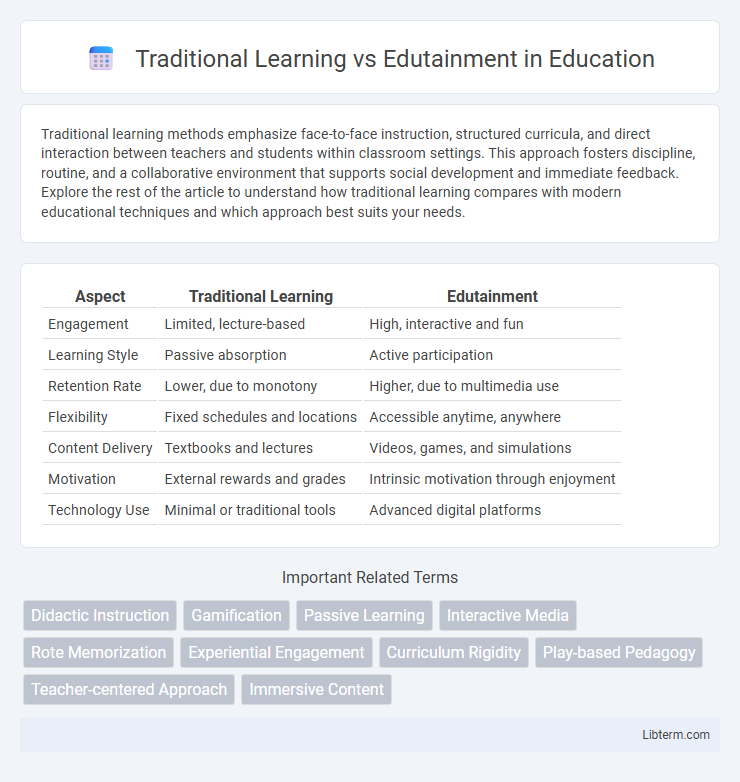Traditional learning methods emphasize face-to-face instruction, structured curricula, and direct interaction between teachers and students within classroom settings. This approach fosters discipline, routine, and a collaborative environment that supports social development and immediate feedback. Explore the rest of the article to understand how traditional learning compares with modern educational techniques and which approach best suits your needs.
Table of Comparison
| Aspect | Traditional Learning | Edutainment |
|---|---|---|
| Engagement | Limited, lecture-based | High, interactive and fun |
| Learning Style | Passive absorption | Active participation |
| Retention Rate | Lower, due to monotony | Higher, due to multimedia use |
| Flexibility | Fixed schedules and locations | Accessible anytime, anywhere |
| Content Delivery | Textbooks and lectures | Videos, games, and simulations |
| Motivation | External rewards and grades | Intrinsic motivation through enjoyment |
| Technology Use | Minimal or traditional tools | Advanced digital platforms |
Introduction to Traditional Learning and Edutainment
Traditional learning relies on structured curricula, lectures, and direct instruction methods to impart knowledge, often emphasizing memorization and standardized assessments. Edutainment combines educational content with entertainment elements such as games, videos, and interactive activities to increase engagement and motivation. This approach leverages multimedia tools and experiential learning to create dynamic, student-centered experiences that enhance retention and practical understanding.
Defining Traditional Learning
Traditional learning is defined as a structured educational approach centered on teacher-led instruction, standardized curricula, and rote memorization, emphasizing passive knowledge absorption and assessment through exams. This conventional method prioritizes discipline, repetition, and clear hierarchical roles within the classroom setting, often limiting interactive and experiential learning opportunities. Rooted in longstanding pedagogical practices, traditional learning aims to deliver foundational knowledge and skills in a controlled environment optimized for uniform academic performance.
Understanding Edutainment
Edutainment blends education and entertainment to enhance learner engagement and retention by incorporating interactive multimedia, gamification, and storytelling techniques. Unlike traditional learning, which often relies on passive lectures and rote memorization, edutainment promotes active participation and experiential learning through dynamic digital platforms and real-world scenarios. This approach leverages cognitive science principles to create immersive environments that cater to diverse learning styles and improve knowledge application.
Key Differences Between Traditional Learning and Edutainment
Traditional learning emphasizes structured curriculum, formal assessment, and instructor-led teaching, often relying on textbooks and lectures to deliver content. Edutainment integrates education with entertainment through interactive media, games, and multimedia, fostering engagement and experiential learning. The key differences lie in the delivery method, with traditional learning focusing on passive absorption of information and edutainment prioritizing active participation and motivation.
Benefits of Traditional Learning
Traditional learning fosters deep knowledge retention through structured curricula and consistent practice, providing a solid foundation in core subjects such as mathematics, science, and language arts. It encourages discipline and time management skills by adhering to fixed schedules and standardized assessments, preparing students for academic and professional environments. This approach supports social development through direct teacher-student interaction and collaborative group activities, enhancing communication and critical thinking abilities.
Advantages of Edutainment in Education
Edutainment enhances student engagement and retention by combining educational content with interactive and entertaining elements, fostering a more dynamic learning environment than traditional methods. It leverages multimedia tools and gamification to cater to various learning styles, promoting creativity, critical thinking, and motivation. Research shows that edutainment improves knowledge acquisition and long-term memory by making learning enjoyable and relatable.
Challenges and Limitations of Traditional Learning
Traditional learning often faces challenges such as limited student engagement, rigidity in curriculum delivery, and insufficient adaptation to diverse learning styles. These limitations can result in reduced motivation and lower retention rates among students. Additionally, traditional methods may struggle to incorporate interactive and multimedia resources that enhance comprehension and critical thinking skills.
Drawbacks and Concerns of Edutainment
Edutainment often risks prioritizing entertainment over educational value, leading to superficial learning and reduced retention of critical concepts. The interactive elements can sometimes distract learners, causing cognitive overload and hindering deep understanding. Furthermore, the reliance on technology in edutainment raises concerns about accessibility, screen time, and the potential for decreased social interaction compared to traditional learning methods.
Impact on Student Engagement and Motivation
Traditional learning methods emphasize structured curriculum and teacher-led instruction, often resulting in passive student participation and limited engagement. Edutainment integrates entertainment elements with educational content, significantly boosting student motivation by making learning interactive and enjoyable. Research shows that edutainment enhances engagement levels by up to 60%, fostering better retention and a positive attitude toward learning.
Choosing the Right Approach: Traditional, Edutainment, or Blended?
Choosing the right educational approach depends on learner needs, goals, and context, where traditional learning offers structured, discipline-focused knowledge through lectures and textbooks, while edutainment integrates engaging multimedia and interactive activities to enhance motivation and retention. Blended learning combines the strengths of both methods, providing balanced cognitive rigor with entertainment elements, fostering deeper understanding and sustained learner engagement. Evaluating curriculum objectives and audience preferences ensures the optimal mix, maximizing educational outcomes and skill acquisition.
Traditional Learning Infographic

 libterm.com
libterm.com